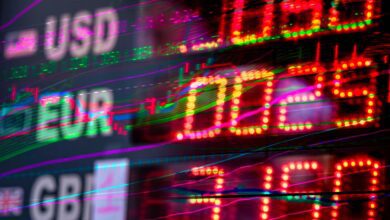Currency Currents: Navigating Interest Rates, Geopolitics, and Central Bank Strategies in Forex Trading

In the complex world of foreign exchange (forex) trading, numerous factors converge to influence currency valuations and market behaviors. Among these, interest rates hold a pivotal role, acting as a barometer for economic health and investor sentiment. As central banks adjust rates in response to inflation, economic growth, and geopolitical events, traders must navigate an intricate landscape where decisions can have immediate and far-reaching consequences. This article delves into the multifaceted relationship between interest rates and currency exchange rates, examining how geopolitical events can sway forex markets, and the strategies traders employ when dealing with major currency pairs like EUR/USD and GBP/USD. We will also explore the critical functions of central banks in shaping currency values, the implications of inflation on trading strategies, and the allure of carry trading amid interest rate differentials. Furthermore, we’ll consider the rise of digital currencies and their disruptive influence on traditional forex markets, alongside methods for leveraging economic indicators to forecast currency movements. Join us as we unpack these essential elements of forex trading, equipping you with the insights needed to navigate this dynamic financial landscape.
- 1. **Interest Rates and Currency Valuations: Unpacking the Connection**
- 2. **Geopolitical Dynamics: Their Role in Forex Market Fluctuations**
- 3. **Central Banks and Inflation: Navigating Strategies in Currency Trading**
1. **Interest Rates and Currency Valuations: Unpacking the Connection**
Interest rates play a crucial role in determining currency valuations in the foreign exchange (forex) market. When a country's central bank adjusts its interest rates, it directly affects the attractiveness of its currency to foreign investors. Higher interest rates offer better returns on investments denominated in that currency, leading to increased demand and, consequently, a rise in its value. Conversely, lower interest rates can deter investment, resulting in a depreciation of the currency.
The connection between interest rates and currency valuations is underpinned by the concept of interest rate differentials. This refers to the difference in interest rates between two countries. Traders often look for opportunities to profit from these differentials by borrowing in a currency with a lower interest rate and investing in a currency with a higher rate, a strategy known as carry trading. For instance, if the European Central Bank raises rates while the Bank of England maintains lower rates, the euro may strengthen against the pound as investors seek higher returns.
Moreover, the expectations surrounding future interest rate changes can significantly influence currency markets. Traders analyze economic indicators, central bank communications, and geopolitical events to gauge potential shifts in monetary policy. For example, if inflation data suggests that a central bank may need to raise rates to curb rising prices, traders might preemptively buy that currency, anticipating an increase in value.
In summary, the interplay of interest rates and currency valuations is a fundamental aspect of forex trading. Understanding this relationship enables traders to make informed decisions based on current monetary policies and economic forecasts, ultimately influencing their trading strategies and risk management approaches.
2. **Geopolitical Dynamics: Their Role in Forex Market Fluctuations**
Geopolitical dynamics play a crucial role in influencing forex market fluctuations, as they can create uncertainty or stability in the global economy. Events such as elections, military conflicts, trade disputes, and diplomatic negotiations can significantly impact investor sentiment and currency values. For instance, a sudden political upheaval in a country may lead to a depreciation of its currency, as investors seek to avoid risk by moving their capital to perceived safer assets or currencies, such as the US dollar or Swiss franc.
Trade agreements and tariffs also have profound effects on exchange rates. When countries engage in trade negotiations, the outcome can alter the economic landscape, affecting trade balances and capital flows. A favorable trade deal may strengthen a nation's currency, while the imposition of tariffs could weaken it by raising costs for consumers and businesses.
Additionally, geopolitical tensions can lead to market volatility. For example, conflicts in oil-producing regions often result in fluctuating oil prices, which can influence currencies of both oil-exporting and oil-importing nations. Similarly, uncertainties surrounding major elections can lead to fluctuations in currency values as traders hedge against potential outcomes.
The response of central banks to geopolitical events can further complicate the situation. Central banks may adjust interest rates or implement monetary policies in reaction to external pressures, which can have immediate effects on forex markets. Traders closely monitor statements and actions from central banks, as these can signal a shift in policy that will influence currency values.
Overall, understanding geopolitical dynamics is essential for forex traders, as these factors can create both opportunities and risks in currency markets. By staying informed on global events and their potential implications, traders can better navigate the complexities of forex trading.
3. **Central Banks and Inflation: Navigating Strategies in Currency Trading**
Central banks play a crucial role in shaping currency values and influencing inflation rates, which in turn affect currency trading strategies. By setting interest rates and implementing monetary policy, central banks can impact economic stability and market perceptions. Traders closely monitor central bank announcements, as changes in interest rates often lead to immediate fluctuations in currency values.
When a central bank raises interest rates, it typically strengthens the national currency. Higher rates offer better returns on investments denominated in that currency, attracting foreign capital and increasing demand. Conversely, a lower interest rate can weaken a currency, as investors seek higher yields elsewhere. Thus, traders often position themselves based on anticipated central bank actions, utilizing tools like interest rate differentials to capitalize on these movements.
Inflation is another critical factor that traders must consider. Central banks aim to control inflation through their monetary policies. When inflation rises beyond a certain threshold, central banks may respond by tightening monetary policy, which can lead to an appreciation of the currency. On the other hand, persistently low inflation may prompt central banks to lower interest rates to stimulate growth, potentially devaluing the currency.
Traders often analyze economic indicators such as Consumer Price Index (CPI) and Producer Price Index (PPI) to gauge inflationary pressures and predict central bank actions. By understanding the relationship between inflation rates and monetary policy, traders can develop informed strategies that align with potential currency movements.
In summary, central banks and inflation are pivotal in navigating currency trading strategies. By closely monitoring interest rate decisions and inflation data, traders can make informed choices that leverage the dynamics of the forex market.
In conclusion, the intricate relationship between interest rates, geopolitical events, central bank policies, and inflation significantly shapes the dynamics of currency exchange rates. Understanding how these factors interconnect is essential for traders and investors navigating the forex market. As we have explored, interest rates not only influence currency valuations but also dictate trading strategies, particularly in the context of carry trading, where interest rate differentials can yield profitable opportunities. Moreover, geopolitical developments introduce volatility that can swiftly alter market sentiment, making adaptability a crucial component of successful trading strategies.
As the rise of digital currencies continues to challenge traditional forex markets, traders must remain vigilant and informed about emerging trends. By leveraging economic indicators, traders can better anticipate currency movements, enhancing their ability to make sound investment decisions. Ultimately, a comprehensive understanding of these fundamental concepts equips traders with the insights needed to navigate the complexities of the forex landscape and optimize their trading strategies in an ever-evolving market.





